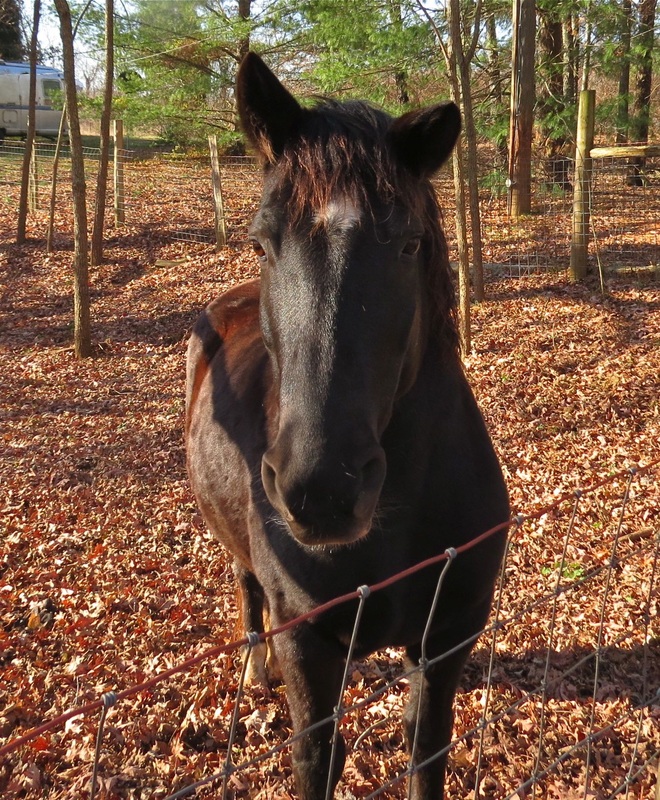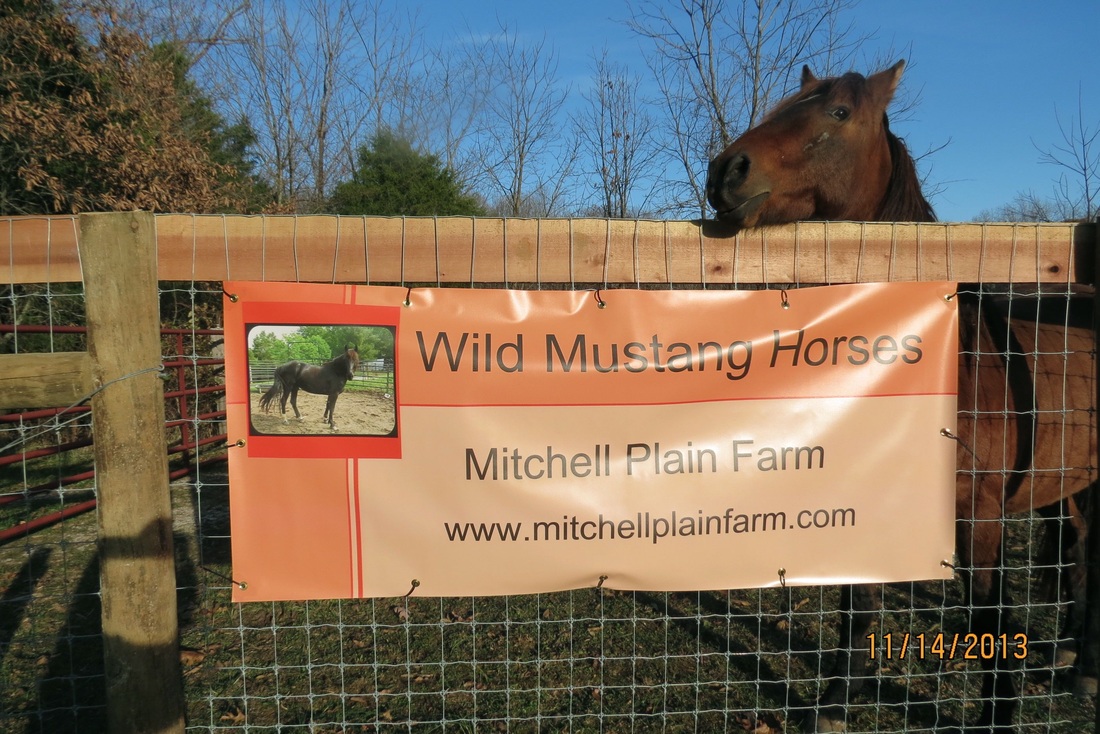More great mustang horse photos on the Contact Page!
|
Comet, 22-year old mustang gelding, with draft horse lineage, abandoned near Central Barren, Indiana, 2008. Learn more about Comet and Montello in an article from our local newspaper, The Corydon Democrat. Photo by GA Lager
|
Montello and her mustang filly, Morning Star, born on farm 09/09/2009. See Morning Star's gallery from birth to 2 years of age on the Our Mustangs Page. Morning Star is also featured on the Dental Care and Development Page. Photo by GA Lager
|
|
Mesteño, 16-year old mustang gelding from Salt Wells Herd Management Area (HMA) Wyoming, featured in the article "The Mustang Hoof".
|
Nevada, 17-year old gelding, was my first mustang adopted through the BLM horse and burro program. Captured near Twin Peaks, Nevada-California border, as a yearling. You can see more of Nevada on the Bitless Bridles and the Natural Hoof Care Pages. Photo by GA Lager
|
About our farm
The Mitchell Plain Farm is located within the sinkhole region of south central Indiana near Central, approximately 10 miles south of Corydon, the county seat of Harrison County. The farm is named after the physiographic division of Indiana (Mitchell Plain or Plateau) characterized by extensive karst topography formed within porous limestone. In addition to sinkholes, other common karst features include caverns, disappearing streams, blue holes and springs. Located nearby are Squire Boone Caverns and Binkley Cave, which is located just south of Corydon (For those of you who are caving enthusiasts refer to the Binkley Cave Page). Potable water for the farm originates from a well within the St. Louis Limestone, a member of the Blue River Group of Mississippian age (rocks formed about 300 million years ago!). The St. Genevieve Limestone, which overlies the St. Louis, is exposed throughout the 32 acres of the farm. Soils have formed in situ by weathering of this limestone and are typically nutrient poor and clay rich (terra rossa). Most horse pastures in the area consist primarily of fescue grass, which if managed properly, will provide grazing throughout the year. Our farm is mostly wooded with about 6 acres in fenced pasture, two barns, several corrals and an outdoor training arena.
We raise a number of different animals but this site is devoted primarily to our wild mustang horses. We hope this web site will promote interest in mustangs within the region and become a unique source for mustang horse information on the web.
We raise a number of different animals but this site is devoted primarily to our wild mustang horses. We hope this web site will promote interest in mustangs within the region and become a unique source for mustang horse information on the web.
Nevada peering over our new banner to promote wild mustangs and the educational material on this web site. Photo by GA Lager
Web Site News:
Recent additions:
1. New webpage on enteroliths (intestinal stones) passed by an Arabian horse living in Louisville, Kentucky. Scientific study on the possible role of trace elements like zinc in the formation and development of enteroliths.
2. Numerous horse barns in this region use commercial bag feeds and supplements to balance equine forage diets. In this section, we evaluate the nutritional program of a Kentuckiana Jumper/Hunter farm that feeds Tribute Kalm 'N EZ and Essential K. Pasture on this farm is very limited (not included in diet balancing) and the primary hay is a relatively low-protein, high fiber Timothy grass. The objective is to see how well commercial products balance deficits for this particular hay and to recommend dietary changes, if necessary.
3. In the wild animals self-select certain herbs and weeds that provide a source of natural medicines for healing and essential minerals for a balanced diet. We can mimic this natural behavior for our horses by cultivating pasture plots for self-selection, or allowing beneficial weeds to grow in our pastures. Read more about the nutritional value of common weeds in this region on the new pasture weeds web page.
4. Do you stable your horse at a barn that uses drinking water from a private well? Check out our new equine nutrition web page (Part 7) on interpreting water analyses from private groundwater wells in limestone areas, such as the Mitchell Plain. A table with livestock water standards is also available for download. Did you know that the Indiana Department of Environmental Management will test your well for about 400 chemical substances free of charge? Read more about this program on the new groundwater page.
5. The last part of the parasite control page briefly introduces the herbal dewormer Verm-X along with a YouTube video presentation by a UK veterinary surgeon on the "Intelligent use of herbal remedies in animal husbandry". Verm-X is a product formulated in the UK, which is now available in the U.S.
Other web pages:
Part 1 on the equine nutrition page discusses carbohydrates levels in hay and pasture in southern Indiana and Kentucky. Part 2 shows how to balance your horse's base diet using local examples of hay and pasture analyses and online software published by the National Research Council (Nutrient Requirements of Horses, 2007). Part 3 discusses how to choose and formulate your own mineral supplements. In Part 4, we focus on Selenium, an important trace mineral with a low threshold of toxicity. Part 5 summarizes the biochemical functions of deficient minerals in local hay/pasture. Also included is a discussion of Iodine deficiency with an analysis of possible supplements (Part 6).
Want to know more about the hoof conformation of wild mustang horses that roam the desert southwest? See our web page on the Wild Mustang Hoof.
We have also added a case study of hoof and limb deformities in our older rescued mare Montello to our page on Natural Hoof Care. The ongoing study includes photos and X-ray radiographs of hooves before and after barefoot trims.
The On-Farm Manure and Mortality Composting page discusses the fate of pathogens and veterinary drugs during composting and how composting can produce high-quality organic fertilizer for your farm projects.
Check out the Farm Blog for interesting stuff about our farm and other animals, including information on controlling internal parasites in small ruminants, pasture weeds as mineral supplements for goats, and a series of articles on how to evaluate your goat's nutritional program (Making Sense of Feed Labels: Balancing Major and Trace Minerals in your Goat's Diet).
Recent additions:
1. New webpage on enteroliths (intestinal stones) passed by an Arabian horse living in Louisville, Kentucky. Scientific study on the possible role of trace elements like zinc in the formation and development of enteroliths.
2. Numerous horse barns in this region use commercial bag feeds and supplements to balance equine forage diets. In this section, we evaluate the nutritional program of a Kentuckiana Jumper/Hunter farm that feeds Tribute Kalm 'N EZ and Essential K. Pasture on this farm is very limited (not included in diet balancing) and the primary hay is a relatively low-protein, high fiber Timothy grass. The objective is to see how well commercial products balance deficits for this particular hay and to recommend dietary changes, if necessary.
3. In the wild animals self-select certain herbs and weeds that provide a source of natural medicines for healing and essential minerals for a balanced diet. We can mimic this natural behavior for our horses by cultivating pasture plots for self-selection, or allowing beneficial weeds to grow in our pastures. Read more about the nutritional value of common weeds in this region on the new pasture weeds web page.
4. Do you stable your horse at a barn that uses drinking water from a private well? Check out our new equine nutrition web page (Part 7) on interpreting water analyses from private groundwater wells in limestone areas, such as the Mitchell Plain. A table with livestock water standards is also available for download. Did you know that the Indiana Department of Environmental Management will test your well for about 400 chemical substances free of charge? Read more about this program on the new groundwater page.
5. The last part of the parasite control page briefly introduces the herbal dewormer Verm-X along with a YouTube video presentation by a UK veterinary surgeon on the "Intelligent use of herbal remedies in animal husbandry". Verm-X is a product formulated in the UK, which is now available in the U.S.
Other web pages:
Part 1 on the equine nutrition page discusses carbohydrates levels in hay and pasture in southern Indiana and Kentucky. Part 2 shows how to balance your horse's base diet using local examples of hay and pasture analyses and online software published by the National Research Council (Nutrient Requirements of Horses, 2007). Part 3 discusses how to choose and formulate your own mineral supplements. In Part 4, we focus on Selenium, an important trace mineral with a low threshold of toxicity. Part 5 summarizes the biochemical functions of deficient minerals in local hay/pasture. Also included is a discussion of Iodine deficiency with an analysis of possible supplements (Part 6).
Want to know more about the hoof conformation of wild mustang horses that roam the desert southwest? See our web page on the Wild Mustang Hoof.
We have also added a case study of hoof and limb deformities in our older rescued mare Montello to our page on Natural Hoof Care. The ongoing study includes photos and X-ray radiographs of hooves before and after barefoot trims.
The On-Farm Manure and Mortality Composting page discusses the fate of pathogens and veterinary drugs during composting and how composting can produce high-quality organic fertilizer for your farm projects.
Check out the Farm Blog for interesting stuff about our farm and other animals, including information on controlling internal parasites in small ruminants, pasture weeds as mineral supplements for goats, and a series of articles on how to evaluate your goat's nutritional program (Making Sense of Feed Labels: Balancing Major and Trace Minerals in your Goat's Diet).





